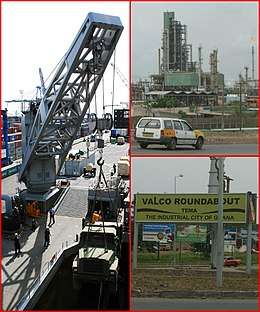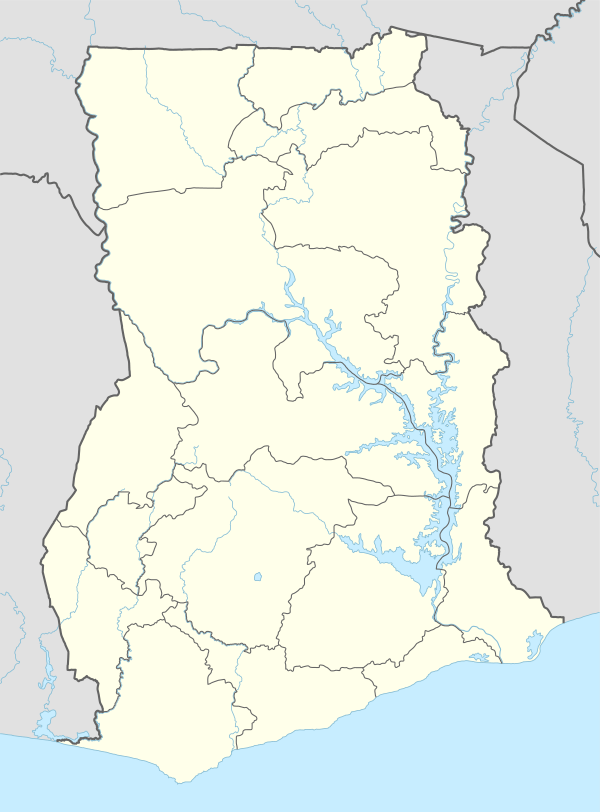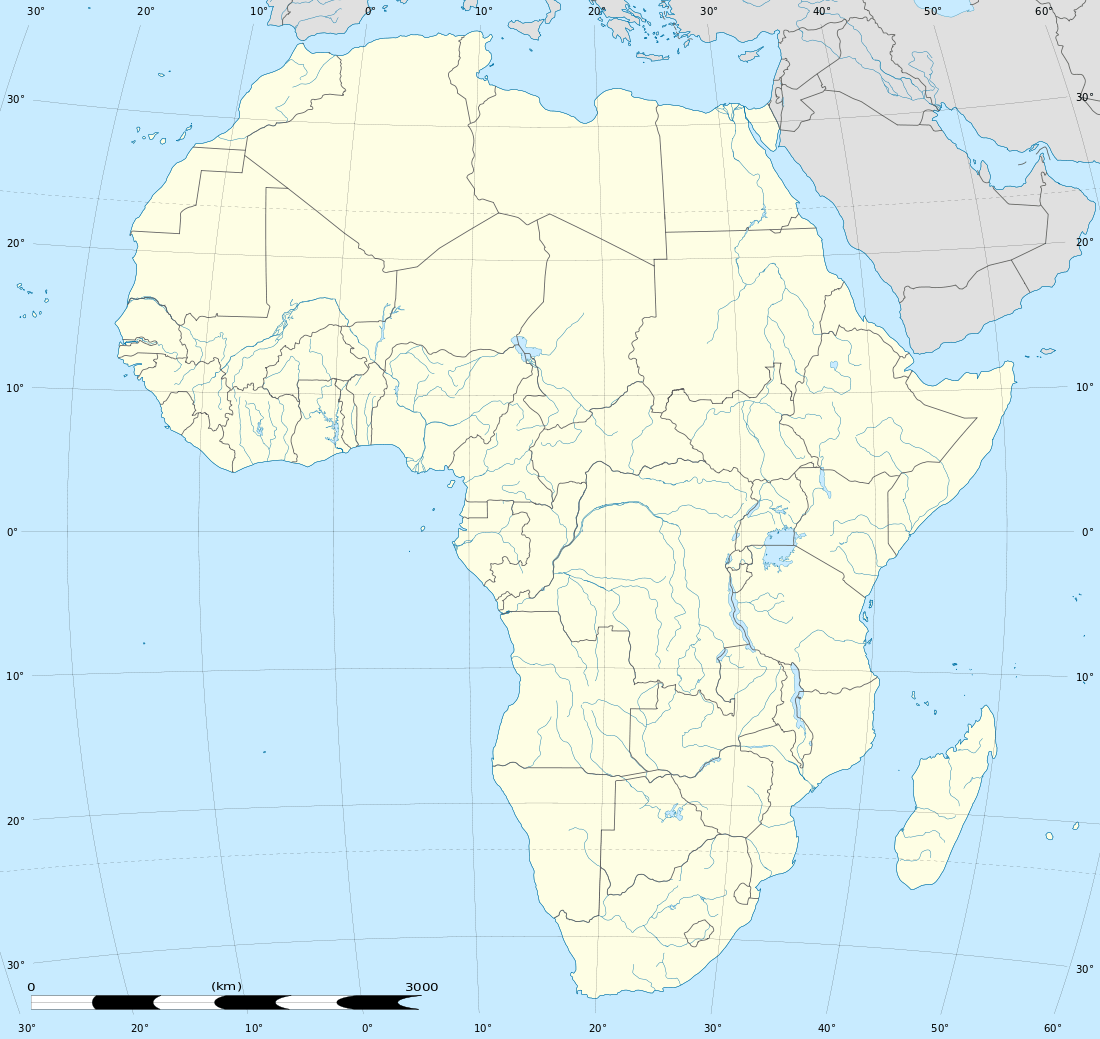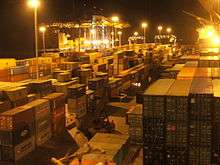Tema
Tema is a city on the Bight of Benin and Atlantic coast of Ghana. It is located 25 kilometres (16 mi) east of the capital city; Accra, in the region of Greater Accra, and is the capital of the Tema Metropolitan District. As of 2013, Tema is the eleventh most populous settlement in Ghana, with a population of approximately 161,612 people – a marked decrease from its 2005 figure of 209,000.[2] The Greenwich Meridian (00 Longitude) passes directly through the city.[3] Tema is locally nicknamed the "Harbour City" because of its status as Ghana's largest seaport. It consists of 25 different communities which are numbered accordingly with each of them having easy access to the basic amenities.[4]
Tema | |
|---|---|
City | |
 First-Left picture: Cargo ships with Intermodal containers being loaded in the Industrial Tema Harbour • First-Top right picture: Petroleum Processing and Refining Plant and Natural-Gas Processing Plant in Tema • Second-Bottom right picture: Valco Roundabout of State-owned Aluminium Corporation Valco (Volta Aluminum Company) in Tema. | |
 Tema  Tema | |
| Coordinates: 05°40′N 00°00′W | |
| Country | |
| Admin. Region | Greater Accra Region |
| District | Tema Metropolitan District |
| Government | |
| • Mayor | Felix Mensah Nii Anang-La |
| Elevation | 1 m (3 ft) |
| Population (2013) | |
| • Total | 161,612[1] |
| Time zone | UTC0 (GMT) |
| • Summer (DST) | GMT |
| Postal codes | GT000 - GT345 |
| Area code(s) | 030 |
| Website | http://tma.gov.gh |
Tema is a city constructed on the site of a small fishing village.[5] Tema was commissioned by Ghana's first president, Kwame Nkrumah, and grew rapidly after the construction of a large harbour in 1961. The Tema metropolis was designed, planned and developed by the award-winning urban planner and Ghana's first architect, Theodore S. Clerk. [6] It is now a major trading centre, home to an oil refinery and numerous factories, and is linked to Accra by a highway and railway. Tema is one of Ghana's two deep seaports, the other being Sekondi-Takoradi.[3] Tema became an Autonomous Council in 1974 and was elevated to the status of a Metropolitan Assembly in December 1990. Tema metropolitan forms part of the sixteen (16) Metropolis, Municipalities and Districts in the Greater Accra Region. The Metropolitan shares boundaries with Ashaiman Municipal, Adenta Municipal District, and Ledzokuku-Krowor Municipal District to the west respectively, to the east with Kpone Katamanso District, to the North with Dangme West District and to the South with the Gulf of Guinea.
History
Tema was built on the site of a small fishing village called Torman, named for the local name of the calabash plant, Tor, which was cultivated there. "Tema" is derived from a corruption of "Torman". The government identified the site before independence, and in 1952 acquired 166 square kilometres (64 sq mi) of land north of the harbour, which was entrusted to the Tema Development Corporation for the new industrial and residential development. The villagers of Torman migrated to a new fishing ground around 3 kilometres (1.9 mi) away, which they called Newtown.[7]
The main Tema Township was constructed, and the Tema Harbour officially opened, in 1962. Over the following decades, Tema grew into the industrial hub of Ghana, with a carefully constructed road layout featuring landscaping and street lights. It boasted modern recreational centres and other social amenities rare among African cities at the time.[7] President Nkrumah appointed Theophilus Asiaw Mills as the first District Commissioner. The importance of Tema as a port and industrial hub is reflected by the fact that the Ghana Police Service maintains a special policing region devoted entirely to the city.
A large population influx began in the 1960s owing to the town's employment opportunities, but the Tema Development Corporation was unable to construct housing and provide other services to meet the needs of the migrants.[8] The Tema Newtown district was overwhelmed by the sudden population growth, and became the poor cousin of Tema Township, receiving none of the latter's improved housing, geometrically laid roads, or social amenities. Moreover, royalties paid by Tema Newtown's companies to evicted villagers have not been used due to a chieftain dispute. The area's fishing potential was thus not fully exploited.[7]
Climate
Tema is characterised by a hot semi-arid climate under the Köppen climate classification (Köppen climate classification: BSh). It lies in the driest part of southern Ghana, experiencing average annual rainfall of about 750 millimetres (30 in). Average temperatures are high year-round, often exceeding 30° Celsius.[3]
| Climate data for Tema | |||||||||||||
|---|---|---|---|---|---|---|---|---|---|---|---|---|---|
| Month | Jan | Feb | Mar | Apr | May | Jun | Jul | Aug | Sep | Oct | Nov | Dec | Year |
| Average high °C (°F) | 32 (89) |
32 (90) |
32 (90) |
33 (91) |
32 (90) |
30 (86) |
28 (82) |
28 (83) |
29 (85) |
30 (86) |
32 (89) |
33 (91) |
33 (91) |
| Average low °C (°F) | 23 (73) |
24 (75) |
24 (76) |
26 (78) |
25 (77) |
24 (75) |
23 (73) |
23 (74) |
24 (75) |
23 (73) |
23 (73) |
24 (76) |
23 (73) |
| Average precipitation mm (inches) | 7.6 (0.3) |
25 (1.0) |
25 (1.0) |
130 (5.0) |
130 (5.0) |
150 (6.0) |
76 (3.0) |
25 (1.0) |
76 (3.0) |
76 (3.0) |
25 (1.0) |
7.6 (0.3) |
750 (29.6) |
| Source: Myweather2.com[9] | |||||||||||||
Economy
Industry

The town's chief industrial products include aluminium, steel, processed fish, refined petroleum, textile, chemicals, food products, and cement.[2] Major companies operating in Tema include Volta Aluminium (VALCO), Tema Oil Refinery (TOR), Nestlé Ghana Ltd., Wahome Steel Ltd, Tema Shipyard.[10] There is also a Free zone enclave in Tema.
Seaport

Tema Port, which was opened in 1962, is the biggest of the two seaports in Ghana. It has a water-enclosed area of 1.7 square kilometres (0.66 sq mi) and a total land area of 3.9 square kilometres (1.5 sq mi). Apart from handling Ghanaian imports and exports, it is also a traffic junction, dealing with transit cargo destined for the landlocked countries of Burkina Faso, Mali and Niger. The port of Tema handles 80% of Ghana's import and export cargo, including the country's chief export, cacao.
The port has 5 kilometres (3.1 mi) of breakwaters, 12 deepwater berths, an outsize oil tanker berth, a dockyard, warehouses, and transit sheds. The port has open and covered areas for the storage of cargo, including a 77,200-m² (7.72-hectare) paved area for the storage of containers, steel products and other conventional cargo. The port's container yard is capable of holding over 8,000 TEUs at any given time. The closed storage area, which is about 25,049 m² (2.51 hectares) in area, consists of six sheds with a total storage capacity of 50,000 tonnes of cargo. The port also includes a 100,000-dwt dry dock and slipway facility.[11] The harbour is operated by the Ghana Ports and Harbours Authority.
Fishing harbour
Ghana has a long history of fishing. The Tema fishing harbour is at the eastern end of the town's commercial harbour. It comprises the Inner Fishing Harbour, the Canoe Basin, the Outer Fishing Harbour, and a commercial area with marketing and cold storage facilities.[8]
The Inner Fishing Harbour was constructed along the Tema Main Port in 1962 to provide a handling facility for semi-industrial and industrial fishing vessels, and to encourage the development of the local fishing industry. In 1965, the Outer Fishing Harbour was constructed for bigger industrial vessels such as trawlers, tuna vessels, and deep-sea carriers.[8] The trawlers operating in the area are 30–45 m long and are able to land 55–65 tonnes of fish (usually redfish and club and scad mackerel) per fishing trip. The tuna vessels range from smaller boats around 45–50 m in length, able to land 200–250 tonnes of catch, to larger versions with a length of 50–65 m and the ability to land up to 650 tonnes per fishing trip.[8] The largest fishing vessels, the deep-sea carriers (with lengths of 90–105 m), are mostly chartered vessels.[8] Since 1984, the national catch has averaged about 200,000 to 300,000 metric tonnes per annum. Ghana's tuna catch has maintained a stable level of 30,000 tonnes per annum since 1981.[8]
The Canoe Basin caters for the artisanal fishermen. The basin is normally occupied by about 400 canoes. These are mainly two types: wooden vessels, locally called "Legelege", and metallic vessels. The wooden canoes have lengths over all (LOA) ranging between 30–70 m, mainly owned and operated by indigenous Ghanaians.[11] Their operations peak during the months of June–September. Artisanal canoe fishing is responsible for about 70% of the catch.[11]
Education
SOS-Hermann Gmeiner International College (SOS-HGIC), a private mixed boarding school catering to the 10th to 13th grades, is located in Tema. It previously used the International General Certificate of Secondary Education (IGCSE) for the 10th and 11th grades and the International Baccalaureate (IB) for the 12th and 13th grades but currently runs the full IB Diploma program for all four grades. The school was headed by Margaret Nkrumah for over 15 years, and is now headed by Mr Israel Titi Ofei and Nii Amaa Akita. Tema also has an international school, Tema International School (TIS), which is second to HGIC, and a senior high school, Tema Secondary School (TSS or Temasco), which was built in 22 September 1961. Tema has a number of public Secondary schools such as Chemu Senior High School in Community 4, Tema Methodist Day School, Mahean Senior High School, Our Lady of Mercy Senior High School and Tema Technical Institute. Private Preparatory Schools like Creator Schools, St Paul Methodist Primary and JHS, Marbs Preparatory School, Datus School Complex, Deks Educational Institute, Angel School Complex, Naylor SDA School, Tema Christian Centre, Tema Parents Association, First Baptist School, Tema Regular Baptist School, Queen Esther School, Dorsons School, Adwen Memorial, Creator Montessori, New Covenant School, St Alban's School, Lorenz Wolf School, Bexhill School Complex, Life International School, Mazon Grace Academy, Santabarbera School, Angels Specialist School, First Star Academy, Pentecost School, Star School Complex, Tema Ridge, St John Bosco School and Rosharon School. Public primary and Junior High schools exist in Tema. Twedaase Primary School, Star School, Aggrey Road School, Republic Road School, Padmore School, Mante Din Drive, Amen Basic, Manhean SDA, School, Bethel Methodist School among others.
Twin cities
| Country | City | County / District / Region / State | Date | |||
|---|---|---|---|---|---|---|
| United Kingdom | Greenwich | Greater London | 1990 | |||
| United States | San Diego | California | 1976 | |||
| United States | Roanoke | Virginia | 2010 | |||
| United States | Columbia | Maryland | 2013 |
References
- "Ghana: Die wichtigsten Orte mit Statistiken zu ihrer Bevölkerung" (in German). World Gazetteer. 2012. Archived from the original on 11 January 2012. Retrieved 9 March 2013.
- Tema Archived 17 May 2011 at the Wayback Machine. GhanaWeb.com. Retrieved 9 March 2013.
- Greater Accra » Tema Metropolitan Archived 2 November 2010 at the Wayback Machine. GhanaDistricts.com. Retrieved 9 March 2013.
- Tema. "Tema Communities". thecityoftema.com. the city of Tema. Retrieved 19 April 2018.
- Jackson, Iain; Oppong, Rexford Assasie (2 October 2014). "The planning of late colonial village housing in the tropics: Tema Manhean, Ghana". Planning Perspectives. 29 (4): 475–499. doi:10.1080/02665433.2013.829753. ISSN 0266-5433.
- Goold, David. "Dictionary of Scottish Architects - DSA Architect Biography Report (July 2, 2017, 11:06 pm)". www.scottisharchitects.org.uk. Archived from the original on 7 April 2017. Retrieved 2 July 2017.
- "Poverty In The Mist of Riches" Archived 4 October 2012 at the Wayback Machine. GhanaWeb.com. Retrieved 9 March 2013.
- Tema Archived 15 July 2011 at the Wayback Machine. OT Africa Line. Retrieved 9 March 2013.
- "Tema Weather Averages". Myweather2. 2013. Retrieved 20 June 2013.
- "P.S.C. Tema Shipyard Ltd". ghanaweb.com. Archived from the original on 24 September 2013. Retrieved 15 July 2013.
- Tema Archived 4 March 2009 at the Wayback Machine. Ghana Ports and Harbours Authority. Retrieved 9 March 2013.
External links
| Wikimedia Commons has media related to Tema. |

